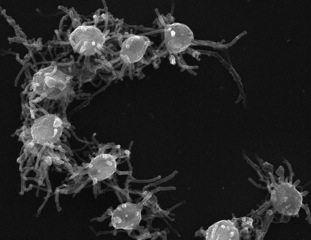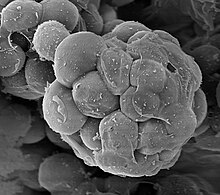
Euglenozoa are a large group of flagellate Discoba. They include a variety of common free-living species, as well as a few important parasites, some of which infect humans. Euglenozoa are represented by four major groups, i.e., Kinetoplastea, Diplonemea, Euglenida, and Symbiontida. Euglenozoa are unicellular, mostly around 15–40 μm (0.00059–0.00157 in) in size, although some euglenids get up to 500 μm (0.020 in) long.

The Percolozoa are a group of colourless, non-photosynthetic Excavata, including many that can transform between amoeboid, flagellate, and cyst stages.

The haptophytes, classified either as the Haptophyta, Haptophytina or Prymnesiophyta, are a clade of algae.

Waders or shorebirds are birds of the order Charadriiformes commonly found wading along shorelines and mudflats in order to forage for food crawling or burrowing in the mud and sand, usually small arthropods such as aquatic insects or crustaceans. The term "wader" is used in Europe, while "shorebird" is used in North America, where "wader" may be used instead to refer to long-legged wading birds such as storks and herons.

Amoebozoa is a major taxonomic group containing about 2,400 described species of amoeboid protists, often possessing blunt, fingerlike, lobose pseudopods and tubular mitochondrial cristae. In traditional classification schemes, Amoebozoa is usually ranked as a phylum within either the kingdom Protista or the kingdom Protozoa. In the classification favored by the International Society of Protistologists, it is retained as an unranked "supergroup" within Eukaryota. Molecular genetic analysis supports Amoebozoa as a monophyletic clade. Modern studies of eukaryotic phylogenetic trees identify it as the sister group to Opisthokonta, another major clade which contains both fungi and animals as well as several other clades comprising some 300 species of unicellular eukaryotes. Amoebozoa and Opisthokonta are sometimes grouped together in a high-level taxon, variously named Unikonta, Amorphea or Opimoda.

Labyrinthulomycetes (ICBN) or Labyrinthulea (ICZN) is a class of protists that produce a network of filaments or tubes, which serve as tracks for the cells to glide along and absorb nutrients for them. The two main groups are the labyrinthulids and thraustochytrids. They are mostly marine, commonly found as parasites on algae and seagrasses or as decomposers on dead plant material. They also include some parasites of marine invertebrates and mixotrophic species that live in a symbiotic relationship with zoochlorella.

The Ichthyosporea are a small group of Opisthokonta in Eukaryota, mostly parasites of fish and other animals.

The Tubulinea are a major grouping of Amoebozoa, including most of the more familiar amoebae genera like Amoeba, Arcella, Difflugia and Hartmannella.

The Archamoebae are a group of protists originally thought to have evolved before the acquisition of mitochondria by eukaryotes. They include genera that are internal parasites or commensals of animals. A few species are human pathogens, causing diseases such as amoebic dysentery. The other genera of archamoebae live in freshwater habitats and are unusual among amoebae in possessing flagella. Most have a single nucleus and flagellum, but the giant amoeba Pelomyxa has many of each.

Blastocladiomycota is one of the currently recognized phyla within the kingdom Fungi. Blastocladiomycota was originally the order Blastocladiales within the phylum Chytridiomycota until molecular and zoospore ultrastructural characters were used to demonstrate it was not monophyletic with Chytridiomycota. The order was first erected by Petersen for a single genus, Blastocladia, which was originally considered a member of the oomycetes. Accordingly, members of Blastocladiomycota are often referred to colloquially as "chytrids." However, some feel "chytrid" should refer only to members of Chytridiomycota. Thus, members of Blastocladiomycota are commonly called "blastoclads" by mycologists. Alternatively, members of Blastocladiomycota, Chytridiomycota, and Neocallimastigomycota lumped together as the zoosporic true fungi. Blastocladiomycota contains 5 families and approximately 12 genera. This early diverging branch of kingdom Fungi is the first to exhibit alternation of generations. As well, two (once) popular model organisms—Allomyces macrogynus and Blastocladiella emersonii—belong to this phylum.
The Chloroflexota are a phylum of bacteria containing isolates with a diversity of phenotypes, including members that are aerobic thermophiles, which use oxygen and grow well in high temperatures; anoxygenic phototrophs, which use light for photosynthesis ; and anaerobic halorespirers, which uses halogenated organics as electron acceptors.

Kickxellomycotina is a fungus grouping. In the subkingdom of Zoopagomyceta Benny, 2007.

Filasterea is a proposed basal Filozoan clade of single-celled ameboid eukaryotes that includes Ministeria and Capsaspora. It is a sister clade to the Choanozoa in which the Choanoflagellatea and Animals appeared, originally proposed by Shalchian-Tabrizi et al. in 2008, based on a phylogenomic analysis with dozens of genes. Filasterea was found to be the sister-group to the clade composed of Metazoa and Choanoflagellata within the Opisthokonta, a finding that has been further corroborated with additional, more taxon-rich, phylogenetic analyses.

The sarcomonads or class Sarcomonadea are a group of amoeboid biciliate protists in the phylum Cercozoa. They are characterized by a propensity to move through gliding on their posterior cilium or through filopodia, a lack of scales or external theca, a soft cell surface without obvious cortical filamentous or membranous skeleton, two cilia without scales or hairs, tubular mitochondrial cristae, near-spherical extrusomes, and a microbody attached to the nucleus.
Haemosporidiasina (Haemosporidia) is a subclass of apicomplexans described by Jacques Euzéby in 1988. The taxon is very similar to Aconoidasida.

Amoebidiidae is a family of single-celled eukaryotes, previously thought to be zygomycete fungi belonging to the class Trichomycetes, but molecular phylogenetic analyses place the family with the opisthokont group Mesomycetozoea. The family was originally called Amoebidiaceae, and considered the sole family of the fungal order Amoebidiales that included two genera: Amoebidium and Paramoebidium. However, Amoebidiidae is now monogeneric as it was recently emended to include only Amoebidium. Species of Amoebidium are considered obligate symbionts of freshwater-dwelling arthropod hosts such as midge larvae and water fleas (Daphnia). However, because Amoebidium species attach to the exoskeleton (exterior) of the host and grow in axenic culture, at least some species may be facultative symbionts.

A protist is any eukaryotic organism that is not an animal, plant, or fungus. The protists do not form a natural group, or clade, since they exclude certain eukaryotes with whom they share a common ancestor; but, like algae or invertebrates, the grouping is used for convenience. In some systems of biological classification, such as the popular five-kingdom scheme proposed by Robert Whittaker in 1969, the protists make up a kingdom called Protista, composed of "organisms which are unicellular or unicellular-colonial and which form no tissues". In the 21st century, the classification shifted toward a two-kingdom system of protists: Chromista and Protozoa.
Endohelea is a proposed clade of eukaryotes that are related to Archaeplastida and the SAR supergroup. They used to be considered heliozoans, but phylogenetically they belong to a group of microorganisms known as Cryptista.

Paramoebidium is a genus of unicellular, symbiotic eukaryotes that inhabit the digestive tract of immature freshwater arthropod hosts. Paramoebidium is classified in the opisthokont class Mesomycetozoea, and is the sole genus in the family Paramoebidiidae. Prior to 2005, Paramoebidium species were tentatively placed with the fungal group Trichomycetes due to their habitation of arthropod guts, host overlap between various Paramoebidium and fungal trichomycete taxa, and similar vegetative growth form.

Paramoebidiidae is a family of single-celled eukaryotes, previously thought to be zygomycete fungi belonging to the class Trichomycetes, but molecular phylogenetic analyses place the family with the opisthokont group Mesomycetozoea. The family was originally called Amoebidiaceae, and considered the sole family of the fungal order Amoebidiales that included two genera, Amoebidium and Paramoebidium. However, Paramoebidium is now the sole genus of the family Paramoebidiidae and Amoebidiidae is likewise monogeneric as it was recently emended to include only Amoebidium. Species of Paramoebidium are obligate symbionts of immature freshwater-dwelling arthropod hosts such as mayfly and stonefly nymphs and black fly larvae. Paramoebidium species attach to the digestive tract lining of their host via a secreted holdfast.
















